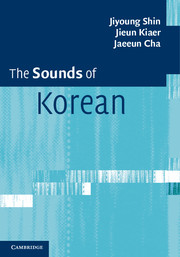Book contents
- Frontmatter
- Contents
- Figures
- Tables
- Preface
- Notational conventions
- 1 Characteristics of the Korean language
- 2 Production of sounds
- 3 Basic concepts of phonology
- 4 Consonants
- 5 Vowels
- 6 Frequency trends of Korean sounds
- 7 Prosody
- 8 Phonological rules of Korean (I)
- 9 Phonological rules of Korean (II)
- 10 Loanword phonology
- Notes
- Bibliography
- Index
2 - Production of sounds
Published online by Cambridge University Press: 05 November 2012
- Frontmatter
- Contents
- Figures
- Tables
- Preface
- Notational conventions
- 1 Characteristics of the Korean language
- 2 Production of sounds
- 3 Basic concepts of phonology
- 4 Consonants
- 5 Vowels
- 6 Frequency trends of Korean sounds
- 7 Prosody
- 8 Phonological rules of Korean (I)
- 9 Phonological rules of Korean (II)
- 10 Loanword phonology
- Notes
- Bibliography
- Index
Summary
Some of you may not be familiar with Korean and may never have even heard the Korean language spoken. Fortunately for you, the vocal organs used to pronounce both Korean and English are almost the same. Moreover, the process of sound production is known to be universal and does not differ from one language to another. We believe that understanding the general process of sound production will help greatly the reader’s understanding of the sounds of Korean and make you feel more familiar with the sounds of the Korean language. Hence, in this chapter, we will discuss the vocal organs that are used in speech production in 2.1, the major cavities in 2.2, the processes of speech production in 2.3 and ways of classifying speech sounds in 2.4.
Overview
In this section, we will examine the various vocal organs involved in the production of speech. Figure 2.1 lists the vocal organs involved in speech production.
- Type
- Chapter
- Information
- The Sounds of Korean , pp. 16 - 39Publisher: Cambridge University PressPrint publication year: 2012

